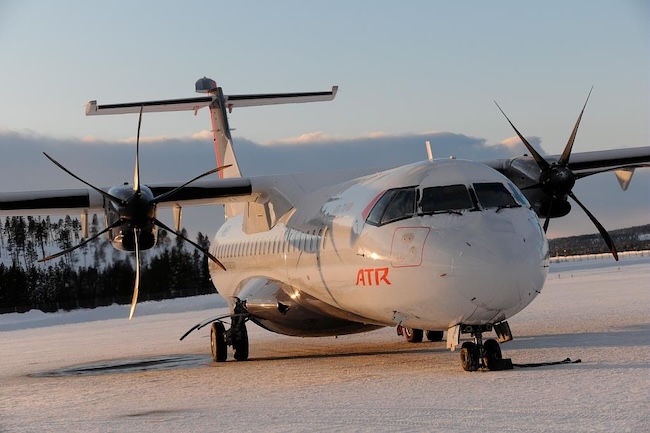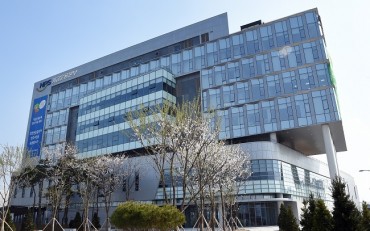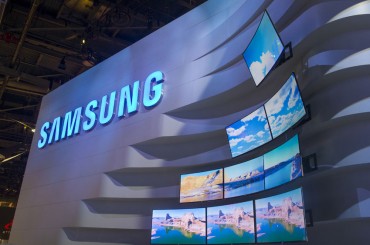TOULOUSE, France, Nov. 12 (Korea Bizwire) — Franco-Italian turboprop maker ATR has touted the strength of its models as it aims to sell aircraft to South Korea by 2030, saying that its aircraft is optimized for short regional flights.
ATR, a joint venture between European airplane giant Airbus and Italian aerospace group Leonardo, wants to sell 25 turboprop aircraft by 2030 in South Korea as the country plans to open three island airports on Ulleung, Baengnyeong, and Heuksan islands in coming years.
Alexis Vidal, senior vice president of commercial at ATR, made the remarks at a briefing with a group of South Korean reporters at the company’s headquarters in Toulouse last week.
“ATR design is optimized for short regional flights. I have been in aviation for 20 years and have been in bigger aircraft as well. I can tell you that they don’t work very well on very short flight sectors,” Vidal said.
In particular, jet engines do not work well on short-duration flights, whereas ATR aircraft are designed for 45-minute to one-hour flights that work in a very reliable manner, he said.
Mentioning ATR’s low carbon dioxide (CO2) emission levels as the second point, the executive said the ATR 72-600 aircraft produces 45 percent less CO2 emissions per trip compared to similarly sized regional jets, such as Brazilian plane maker Embraer’s E175.
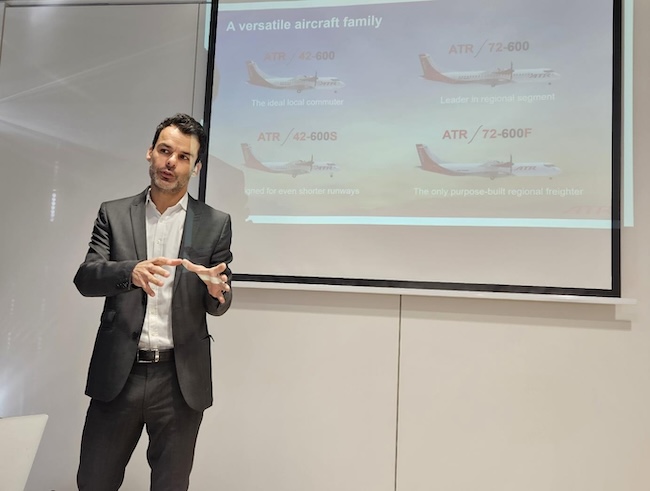
This photo taken on Nov. 6, 2023 (local time), shows ATR Senior Vice President of Commercial Alexis Vidal briefing on the turboprop aircraft maker’s business plans in South Korea during a media event held for Korean reporters at its headquarters in Toulouse. (Image courtesy of Yonhap)
“And the third and last but very important is unbeatable economics or cost effectiveness,” Vidal said. “To develop regional connectivity in Korea for the islands, for west to east, or for even neighbor countries, you need an affordable and cost-effective aircraft.”
ATR sells three models — the ATR 42-600 with 30-50 seats, the ATR 72-600 with 44-78 seats, and the ATR 72-600F freighter. The ATR 42-600S short takeoff and landing (STOL) capable of landing in an 800 meter-long runway is under development.
Five major suppliers provide their parts to ATR, and the turboprop company assembles them into the finished products in its Toulouse plant.
Pratt & Whitney Canada supplies engines, with Airbus Atlantic, Safran S.A., Collins Aerospace and Leonardo offering wings, landing gears, propellers and body parts, respectively.
It currently uses sustainable aviation fuel (SAF) for 50 percent of its fuel and targets to raise the ratio to 100 percent in 2025.
For the Korean market, ATR recommended the ATR 72-600 for passenger transportation, initially in the Ulleung Island airport with a 1,200-meter runway set to be built in 2026.
In South Korea, Hi Air Korea Co., currently under bankruptcy protection, was the only operator of ATR aircraft. It leased one ATR72-500 from ATR and bought three second-hand ones in the markets for four domestic routes all suspended for now.
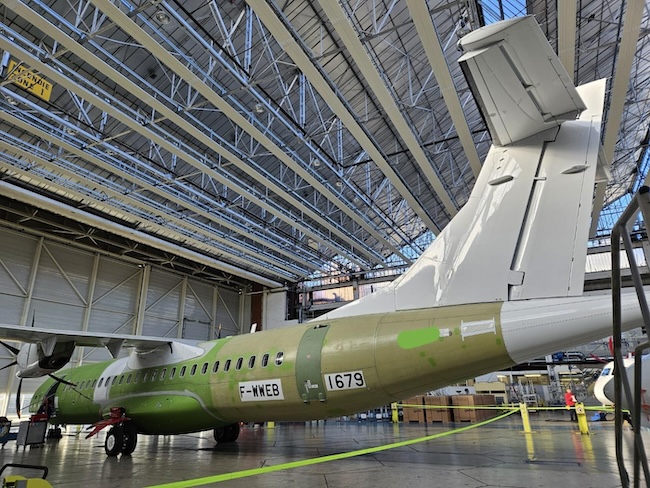
This photo taken on Nov. 7, 2023, shows the ATR 72-600 aircraft being assembled at ATR’s plant in Toulouse. (Image courtesy of Yonhap)
With Hi Air looking for a buyer, ATR said it is in discussions with Sum Air, a wholly owned unit of South Korean mobility platform startup Mobility As a Freedom (MAAF), for the supply of its aircraft.
“Their (Sum Air’s) phase now is looking for financing. And we have three (other) Korean startups contacting us but they want to stay anonymous,” ATR Sales Director Jean-Daniel Kosowski said.
As for possible deals with Korean low-cost carriers, he said they have shown no interest in ATR aircraft up to now.
Sum Air Co. Chief Executive Choi Yong-duck confirmed the company has a plan to purchase ATR aircraft to start regional aviation services in Korea.
“We will submit documents to the transport ministry for a business license and an air operator certificate (AOC) after signing a purchase agreement with ATR,” Choi told Yonhap News Agency over the phone.
Once it obtains government approval, Sum Air plans to provide domestic flights and then international routes to cities in neighbor countries, such as Kyushu in Japan, he said.

This photo taken on Nov. 7, 2023, shows Eerika Somersalo, head of airline marketing at ATR, delivering a briefing on ATR aircraft’s merits to South Korean reporters at the company’s customer experience center in Toulouse. (Image courtesy of Yonhap)
ATR wants to accelerate the sustainable connections for the people, the communities, and the businesses around the world, no matter how remote they are on islands or in mountains as an example. It wants to provide the most efficient and lowest-emission aircraft in the market, he said.
In the Asia-Pacific region, ATR has “a large footprint” but appears to feel the need to make a presence in the Korean market to grow further.
There are nearly 500 ATRs in Asia, which is three times more than Embraer’s E-Jets.
Twenty ATRs are currently serving in Japan, with the number expected to reach 50 over the next five years. In Taiwan, 24 ATRs are in operation, and the number will likely rise to 30 over the next five to seven years.
In China, the ATR 42-600 was certified and approved to fly in November last year, with the number forecast to reach 20 to 30 over the next five years.
Also in Korea, ATR sees unexplored growth potential to connect Korea and islands in the country and also in connections to Japan and China from Korea. And that is with passengers and cargoes, Vidal said.
“Potential direct cargo flights linking Korea to secondary cities in Japan and China, this enables next-day e-commerce delivery,” he added.
(Yonhap)


